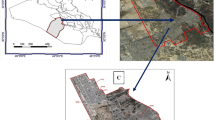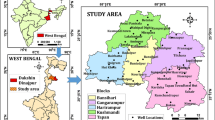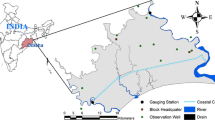Abstract
To evolve a proper management scenario for groundwater utilization, identification of groundwater potential zones is an important step. In the present study, an attempt has been made to identify possible groundwater potential zones both in terms of quantity and quality. A methodology is proposed for identification of groundwater potential index (GWPI) and a new water quality index (WQI) based on analytic hierarchy process. The proposed methodology has been applied to the shallow alluvial aquifer of central Ganga basin, Kanpur (India). Land use/land cover, soil, geology, recharge rate, drainage density, rainfall, slope, elevation, normalized difference vegetation index, groundwater depth or depth to groundwater table are used for GWPI calculation. Moreover, WQI considers alkalinity (as CaCO3), magnesium (Mg2+), total dissolved solids and fluoride (F−) as influencing attributes. Final integration of attributes yield GWPI and WQI map. The resulting GWPI map has been classified into three groundwater potential zones namely: good, moderate and poor covering 26.94, 43.76, and 29.30 %, area, respectively. The WQI map has been classified into five quality zones namely: above permissible limit, poor, moderate, good, very good covering 12.39, 7.63, 15.17, 38.18, and 26.64 % area, respectively. Monitoring data from well locations along with GWPI and WQI map reveals the proper potential zones. This analysis demonstrates the potential applicability of the methodology for a general aquifer system.







Similar content being viewed by others
References
Alonso J, Lamata T (2006) Consistency in the analytic hierarchy process: a new approach. Int J Uncertain Fuzziness Knowl Based Syst 14(4):445–459
Anbazhagan S, Nair AM (2004) Geographical information system and groundwater quality mapping in Panvel Basin, Maharashtra, India. Environ Geol 45:753–761
BIS (1991) Indian standard for drinking water—specification IS 10500:1991. http://www.indiawaterportal.org/articles/indian-standard-drinking-water-bis-specifications-10500-1991. Accessed Aug 2014
Champidi P, Stamatis G, Zagana E (2011) Groundwater quality assessment and geogenic and anthropogenic effect estimation in Erasinos basin, East Attica. Eur Water 33:11–27
Chowdhury A, Jha MK, Chowdary VM, Mal BC (2009) Integrated remote sensing and GIS based approach for assessing groundwater potential in West Medinipur district, West Bengal, India. Int J Remote Sens 30(1):231–250
Deepika B, Kumar A, Jayappa KS (2013) Integration of hydrological factors and demarcation of groundwater prospect zones: insights from remote sensing and GIS techniques. Environ Earth Sci 70:1319–1338
Dhakate R, Chowdhary DK, Rao VVSG, Tiwary RK, Sinha A (2012) Geophysical and geomorphological approach for locating groundwater potential zones in Sukinda chromite mining area. Environ Earth Sci 66:2311–2325
Dhar A (2013) Geostatistics-based design of regional groundwater monitoring framework. ISH J Hydraul Eng 19(2):80–87
Dhar A, Sahoo S, Dey S, Sahoo M (2014a) Evaluation of recharge and groundwater dynamics of a shallow alluvial aquifer in central Ganga basin, Kanpur (India). Nat Resour Res 23(4):409–422
Dhar A, Sahoo S, Mandal U, Dey S, Bishi N, Kar A (2014b) Hydro-environmental assessment of a regional ground water aquifer: Hirakud command area (India). Environ Earth Sci. doi:10.1007/s12665-014-3703-x
Griffith JA (2002) Geographic techniques and recent applications of remote sensing to landscape-water quality studies. Water Air Soil Pollut 138:181–197
Huang CC, Yeh HF, Lin HI, Lee ST, Hsu KC, Lee CH (2013) Groundwater recharge and exploitative potential zone mapping using GIS and GOD techniques. Environ Earth Sci 68:267–280
Ierodiaconou D, Laurenson L, Leblanc M, Stagnitti F, Duff G, Salzman S, Ver-sace V (2005) The consequences of land use change on nutrient exports: a regional scale assessment in south-west Victoria, Australia. J Environ Manag 74:305–316
Jaiswal RK, Mukherjee S, Krishnamurthy J, Saxena R (2003) Role of remote sensing and GIS techniques for generation of groundwater prospect zones towards rural development: an approach. Int J Remote Sens 24:993–1008
Jha MK, Peiffer S (2006) Applications of remote sensing and GIS technologies in groundwater hydrology: past, present and future. BayCEER, Bayreuth, p 201
Kamaraju MVV, Bhattacharya A, Srinivasa Reddy G, Chandrasekhar Rao G, Murthy GS, Malleswara Rao TCH (1996) Groundwater potential evaluation of west Godavari district, A.P., India—a GIS approach. Groundwater, (2), pp 318–325
Karanth KR, Seshu Babu K (1978) Identification of major lineaments on satellite imagery and on aerial photographs for delineation for possible potential groundwater zones in Penukonda and Dharmavaram taluks of Anantapur district. In: Proceedings of joint indo-US workshop on remote sensing of water resources (NRSA, Hyderabad), 188–197. Indian society of remote sensing (ISRS) National natural resources management system (NNRMS), Ahmedabad, India
Khan MA, Maharana PC (2002) Use of remote sensing and GIS in the delineation and characterization of groundwater prospect zones. Photonirvachak J Indian Soc Remote Sens 30:131–141
Khan S, Mohd A (1997) GIS approach for water resource assessment in parts of Rajasthan and Haryana using remote sensing techniques. In: Proceedings of natural symposium on remote sensing for natural resources (Pune, India, 4–6 December 1996). Indian society of remote sensing (ISRS) National natural resources management system (NNRMS), Ahmedabad, India, pp 75–82
Krishnamurthy J, Srinivas G (1995) Role of geological and geomorphological factors in groundwater exploration: a study using IRS LISS data. Int J Remote Sens 16:2595–2618
Krishnamurthy J, Mani AN, Jayaram V, Manivel M (2000) Groundwater resources development in hard rock terrain: an approach using remote sensing and GIS techniques. Int J Appl Earth Obs Geoinform 2:204–215
Kshetrimayum KS, Bajpai VN (2012) Assessment of groundwater quality for irrigation use and evolution of hydrochemical facies in the Markanda river basin. J Geol Soc India 79(2):189–198
Kumar A (1999) Sustainable utilization of water resources in watershed perspective—a case study in Alaunja watershed, Hazaribagh, Bihar. Photonirvachak J Indian Soc Remote Sens 27:13–22
Madrucci V, Taioli F, Araujo CCD (2008) Groundwater favorability map using GIS multicriteria data analysis on crystalline terrain, São Paulo State, Brazil. J Hydrol 357:153–173
Magesh NS, Chandrasekar N, Soundranayagam JP (2012) Delineation of groundwater potential zones in Theni district, Tamil Nadu, using remote sensing, GIS and MIF techniques. Geosci Front 3(2):189–196
Murthy KSR (2000) Groundwater potential in a semi-arid region of Andhra Pradesh: a GIS approach. Int J Remote Sens 21:1867–1884
Nag SK, Ghosh P (2013) Delineation of groundwater potential zone in Chhatna Block, Bankura District, West Bengal, India using remote sensing and GIS techniques. Environ Earth Sci 70:2115–2127
Pandian K, Sankar K (2007) Hydrochemistry and groundwater quality in the Vaippar river basin, Tamil Nadu. J Geol Soc India 69(5):970–982
Pearce D (1994) Integrated Management of Water Resource in the Context of Sustainable Management. Presentation to the Course in Integrated Water Resources Management, April 11. University of Malta
Prasad RK, Mondal NC, Banerjee P, Nandakumar MV, Singh VS (2008) Deciphering potential groundwater zone in hard rock through the application of GIS. Environ Geol 55(3):467–475
Rao PJ, Harikrishna P, Srivastav SK, Satyanarayana PVV, Rao BBD (2009) Selection of groundwater potential zones in and around Madhurwada Dome, Visakhapatnam District—a GIS approach. J Indian Geophyl Union 13(4):191–200
Ravindran KV (1997) Drainage morphometry analysis and its correlation with geology, geomorphology and groundwater prospects in Zuvari basin, South Goa—using RS & GIS. In: Proceedings of natural symposium remote sensing for natural resources with special emphasis on water management (Pune, India, 4–6 December 1996). Indian society of remote sensing (ISRS) National natural resources management system (NNRMS), Ahmedabad, India, pp 270–296
Rothwell JJ, Dise NB, Taylor KG, Allott TEH, Scholefield P, Davies H, Neal C (2010) A spatial and seasonal assessment of river water chemistry across North West England. Sci Total Environ 408:841–855
Rouse JW, Haas RH, Schell JA, Deering DW (1973) Monitoring vegetation systems in the great Plain with ERTS, Third ERTS Symposium, NASA SP-351I, pp 309–317
Saaty TL (1980) The analytic hierarchy process. McGraW-Hill, New York
Sahid S, Nath SK (2002) GIS integration of remote sensing and electrical sounding data for hydrogeological exploration. J Spat Hydrol 2:1–10
Saini RK, Chakrapani GJ, Sen AK (2006) Geochemical studies of ground water in Saharanpur, (U.P). J Geol Soc India 68(1):247–667
Saraf AK, Choudhury PR (1998) Integrated remote sensing and GIS for groundwater exploration and identification of artificial recharge sites. Int J Remote Sens 19:1825–1841
Saraf AK, Jain SK (1994) Integrated use of remote sensing and geographical information system methods for groundwater exploration in parts of Lalitpur District, UP. In: International Conference on Hydrology and Water Resources (New Delhi, 20–22 December 1993. Kluwer Academic Publishers, Dordrecht, The Netherlands
Sargaonkar AP, Rathi B, Baile A (2011) Identifying potential sites for artificial groundwater recharge in sub-watershed of River Kanhan, India. Environ Earth Sci 62:1099–1108
Shahid S, Nath SK, Ray J (2000) Groundwater potential modeling in softrock using a GIS. Int J Remote Sens 21:1919–1924
Singh AK, Tewary BK, Sinha A (2011a) Hydrochemistry and quality assessment of groundwater in part of Noida metropolitan city Uttar Pradesh, India. J Geol Soc India 78(6):523–540
Singh CK, Shashtri S, Singh A, Mukherjee S (2011b) Quantitative modeling of groundwater in Satluj River basin of Rupnagar district of Punjab using remote sensing and geographic information system. Environ Earth Sci 62:871–881
Solomon S, Quiel F (2006) Groundwater study using remote sensing and geographic information system (GIS) in the central highlands of Eritrea. Hydrogeol J 14:729–741
Sreedevi PD, Subrahmanyam K, Ahmed S (2005) Integrated approach for delineating potential zones to explore for groundwater in the Pageru River basin, Kuddapah District, Andhra Pradesh, India. Hydrogeol J 13:534–545
Srinivasa Rao Y, Jugran DK (2003) Delineation of groundwater potential zones and zones of groundwater quality suitable for domestic purposes using remote sensing and GIS. Hydrol Sci J 48(5):821–833
Srivastav P, Bhattacharya AK (2000) Delineation of groundwater potential zones in hard rock terrain of Bargarh District, Orissa using IRS. J Indian Soc Remote Sens 28(2–3):129–140
Acknowledgments
Authors are thankful to Ground Water Department, UP Government, India, for their help in this research work. The authors would like to thank the anonymous reviewer for providing valuable comments and suggestions to improve the quality of the paper.
Author information
Authors and Affiliations
Corresponding author
Rights and permissions
About this article
Cite this article
Dhar, A., Sahoo, S. & Sahoo, M. Identification of groundwater potential zones considering water quality aspect. Environ Earth Sci 74, 5663–5675 (2015). https://doi.org/10.1007/s12665-015-4580-7
Received:
Accepted:
Published:
Issue Date:
DOI: https://doi.org/10.1007/s12665-015-4580-7




